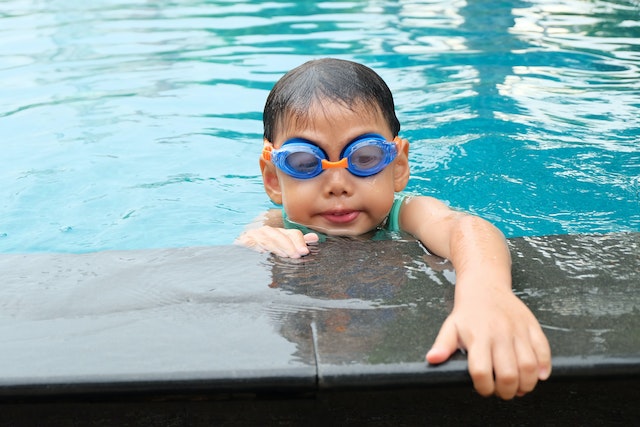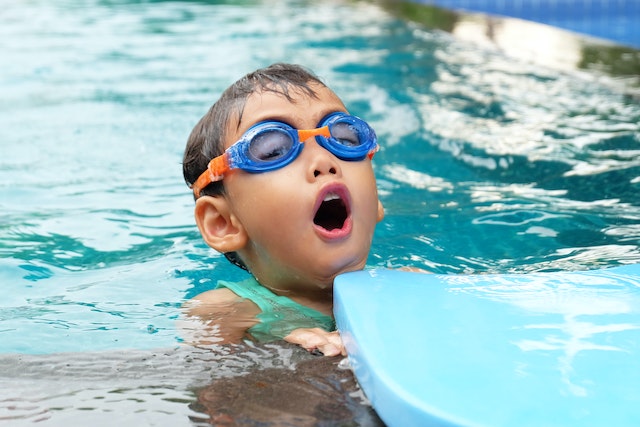It is important that all children understand water survival skills and be able to swim. Swimming lessons won’t eliminate the risk of drowning entirely, but they can help children prevent tragic accidents in the water and make them feel much safer around it, especially for children one-year-old and older. The question here is, when to start?
Vagabondish is reader-supported. When you buy through links on our site, we may earn a small affiliate commission. Read our disclosure.
Best Age to Start
Studies from the American Academy of Pediatrics say that it is best for a child to start learning the basics of swimming between 1 and 4 years old. However, toddlers from 6 months to 3 should take a swim lesson to get familiarized with the water while having fun. These lessons also teach important water safety skills for parents to better educate and protect their children. Don’t worry if your child is 4 years old or older. It’s never too late to learn. From the age of 4, children begin to understand swimming techniques. The best way to help your child get used to the water is to enroll your child from 6 months to 4 years of age in swimming lessons. This early acclimatization encourages them not to be afraid to swim when classes get more difficult.
Swim Lessons for Babies
Infant water programs are often comfortable for both parents and babies. The APP does not recommend actual swimming lessons. This means that they cannot swim independently. Additionally, there is not a shred of evidence that toddler swimming lessons reduce the risk of drowning. There is no substitute for the need for parental supervision on the waterfront. However, the AAP recommends classes that include both parent and child pairs in water activities that give babies a chance to get used to the water. If you’re looking for classes for you and your baby, employing instructors certified by the Red Cross in both lifeguarding and first aid/resuscitation, you’ll look for programs that promise underwater fun and have intentions of teaching young children to swim.
What to Look for in Swimming Lessons?
Here are some other things to look for in a swimming program:
- You can observe the lessons to see if the lesson style fits your needs and is fun for you and your baby
- A low-pressure atmosphere that does not force or encourage head submersion when the baby is anxious or hesitant
- Keeping the pool clean and at the right temperature
- Offer small classes, not more than 10 participants
- Parents must be in the pool during toddler swimming lessons
Swim Lessons for Toddlers
Although most young children and toddlers are not ready to master complex swimming styles or swim independently, the AAP recommends swimming lessons for children ages 1-4. Some studies have shown that swimming lessons can reduce drowning rates. These results may be connected to the water skills young children are learning. However, early swimming lessons do not replace adult supervision. Similar to swimming lessons for toddlers, lessons for children under 4 should involve both children and parents to learn safe water habits. These classes are also essential for building swimming skills, but many children aren’t ready to swim on their own until their fourth birthday. Some parents are convinced that swimming lessons should start early so that their child will be able to swim fast. However, a previous study of children’s willingness to learn freestyle swimming found that children who started lessons at the ages of 2-4 were good swimmers at about the average age of 5.5 years. If your child does not appear to be interested in learning to swim, it is a good idea to keep them playing in the water and enroll them in formal classes when they are a little older.

Swim Lessons for Kids
Considering their development, most children are ready for swimming lessons around the age of four. By this age, most children will be able to coordinate stroke and kick movements, which are key skills for successful swimming. In addition, the AAP emphasizes that swimming lessons are essential for teaching water safety techniques to all children aged four and up. When you enroll your child in swimming lessons, make sure the program contains a safety-certified instructor. It also helps to find progressive programs that allow your child to level up as they learn new skills. If possible, take a class or two first before committing. Learning to swim is an important and healthy life skill that you should definitely teach your child. Swimming is also a great way to train your body, and it becomes a lifelong sport well into old age. If your child really enjoys swimming, you should consider having him or her join a local or competitive swim team.
What If a Child Doesn’t Like It?
If you introduce your child to the pool or enroll him or her in swimming lessons and find that he or she isn’t enjoying them, don’t worry. There are some steps you can take to make the experience much better for both of you and to encourage them to see it differently.
Start at home: Get your child familiarized with the water at home before or between formal swimming classes. Bath time is a great time to get them used to being in the water. Show them how fun it can be by popping soap bubbles or squirting tiny water squirts.
Let them watch you or others swim: If your child doesn’t want to go to swimming lessons because they are afraid or unsure of what to expect, let them see you and other children their age enjoying the pool. Your child should see swimming as a fun activity, not a lesson or an obstacle.
Make it fun: Don’t let swimming become a source of worry or stress for your child. Make it a fun and exciting time by implementing rewards, goals, and activities. Billiard games are motivational and help your child subconsciously learn how to float and kick water. You should consider using different toys and items to make swimming time more entertaining, such as swim noodles, snorkels, and goggles.
Don’t force it: If you are making 100% effort to teach your child to enjoy swimming and it is not working, it’s best to leave it alone. Maybe in the future, they will become curious about it once again.
Enrolling your child in quality swimming lessons as soon as they are ready is one of several important ways to prevent drowning. Talk to experts if you are still not quite sure whether your child is ready for swimming lessons and how to find the best program for your family.


